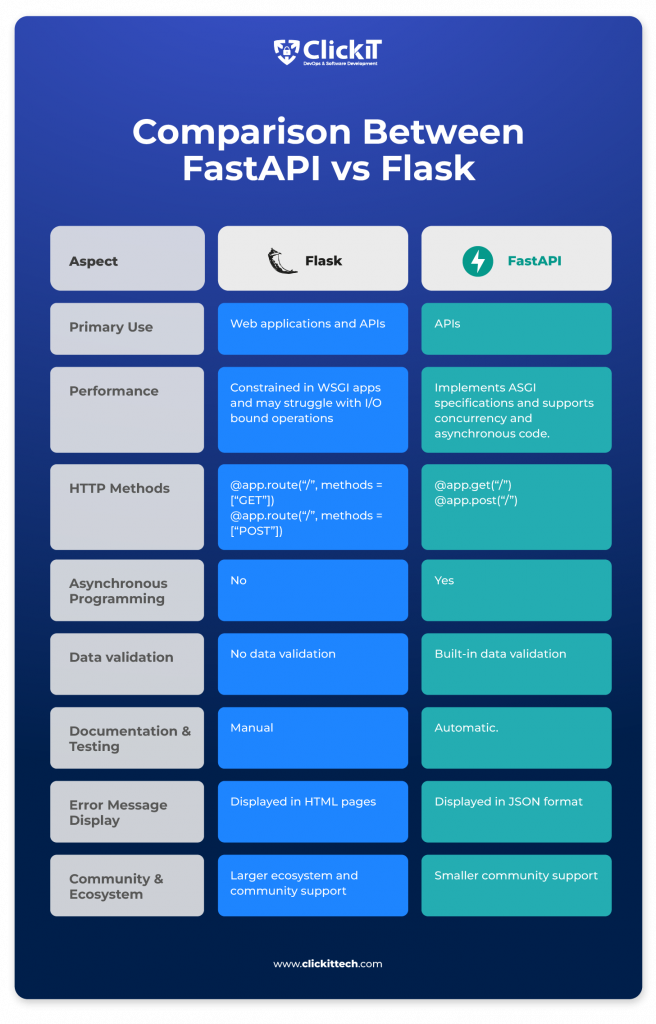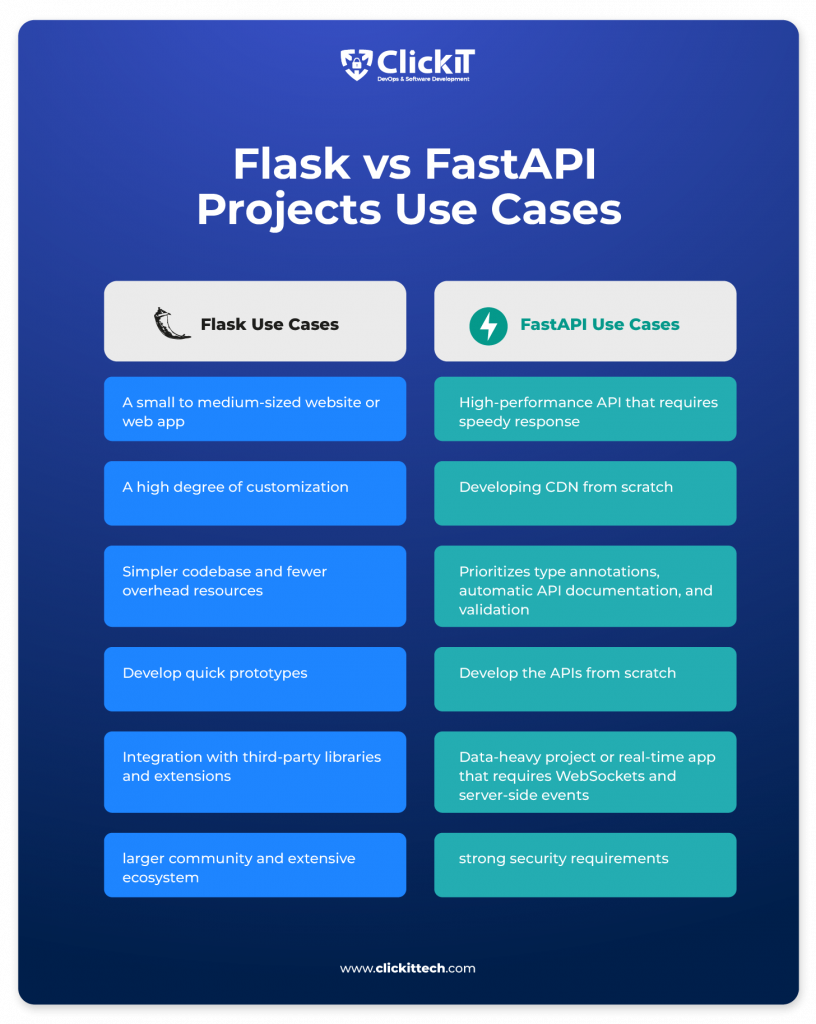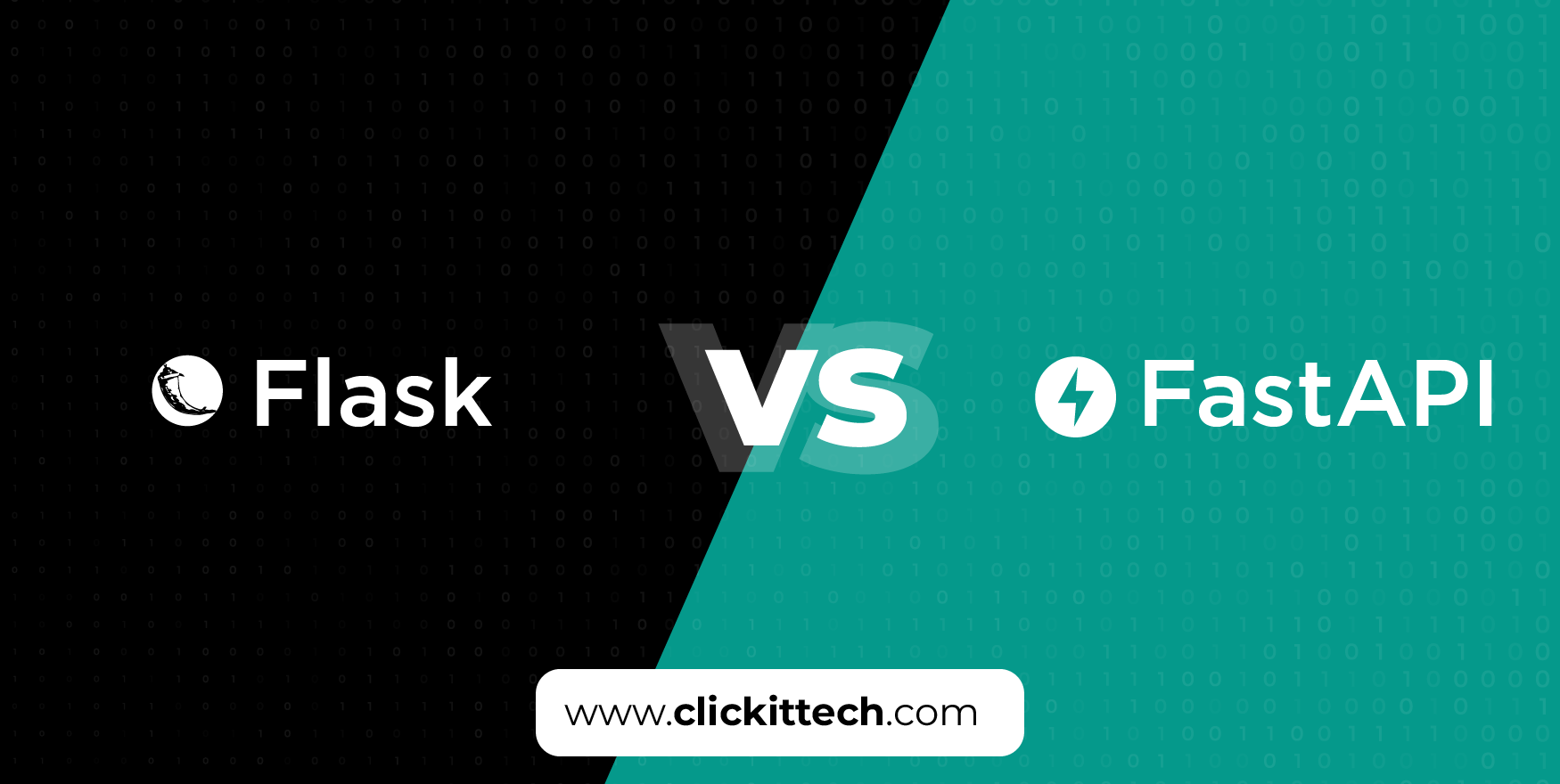One of the perks we enjoy as software engineers is choice. It’s almost like for every tool, technology, language, or process, there is always an alternative like Python FastAPI vs Flask and languages, such as TypeScript vs JavaScript, open source platforms like Kubernetes vs Docker.
However, choice comes with a catch – you have to make informed decisions based on the needs of each project. FastAPI and Flask are both frameworks for developing web applications in Python. Each has its advantages and disadvantages, and the choice largely depends on the project.
That’s why we’ll discuss all the differences between Python Flask vs FastAPI, and even chip in with a comparison with Django and project use cases to help you pick the best one.
Table of contents
- Web Development Frameworks
- What is Flask?
- What is FastAPI?
- Main Differences Between Flask vs FastAPI
- Comparison Table Between FastAPI vs Flask
- Flask vs FastAPI Projects Use Cases
- Flask vs FastAPI vs Django
- Overview of the Flask vs FastAPI vs Django Comparison
- The Ideal Web Development Partner
- Conclusion
- FAQs
Web Development Frameworks
Before getting into the FastAPI vs Flask debate, let’s briefly discuss the basics of a web development framework.
Building a web application from the ground up is tedious, time-consuming, and error-prone. Thankfully, you don’t have to go through such a long process. This is why we have web development frameworks, which are a collection of pre-built libraries, modules, classes, tools, and APIs that help web developers write applications without worrying about the little details, such as routing, HTTP handling, database abstraction, etc.
Python Frameworks
Generally, most popular programming languages have compatible frameworks designed to make development easier and faster within that language.
Therefore, just like JavaScript, TypeScript, PHP, and others, Python, also has frameworks; this means whenever you’re building a project using Python, some frameworks can help you fast-track the process.
Two of the most widely-used Python web frameworks are Flask and FastAPI.
Now, let’s see what each one is about.

What is Flask?
Flask is a lightweight Python-based micro-framework that doesn’t require particular libraries or tools. This means that it provides the bare essentials you need to build a web application but has an easily extensible core to add application features that look like they were implemented in Flask.
So, it’s like building a custom house for yourself. You can choose the layout, designs, number of rooms, and every other feature based on your needs.
In addition, Flask is built on the Web Server Gateway Interface – WSGI. It’s simply a way for web servers to send requests to web applications or frameworks.
As an open-source framework, Flask is best used to build small- to medium-sized web applications that require a lot of customization and flexibility.
Also, many developers love its flexibility, modular approach, and lightweight design because it gives them the freedom to tailor their stack. No wonder it is one of the Top 15 most desired web frameworks according to Stack Overflow’s 2023 survey.
That’s not bad for a microframework, is it?
FastAPI vs Flask: Features of Flask
- It’s a lightweight framework, so that means low overhead code and resources.
- Flask is minimalistic and only covers the basics of web application development. It doesn’t have features like form validation or Object Relational Mapping (ORM) out of the box, but if needed, you can add them using extensions.
- It’s highly flexible and customizable, so you can choose libraries, components, and extensions that fit your project requirements.
- It’s easy to learn, so it’s great for Python beginners.
- Flask has a strong community and ecosystem, so you never run out of help, extensions, or plugins!
What is FastAPI?
FastAPI is a modern, performant web framework for building APIs with Python 3.8 and newer versions. The open-source Python framework was launched in 2018 to be an improvement on existing frameworks like Flask and DRF.
Just as its name implies, FastAPI is truly fast.
It is ideal for building high-performance APIs with minimal code, which is why data-heavy sites like Netflix and Uber use it. Another impressive use of FastAPI you might not have known is in the OpenAPI project.
Additionally, FastAPI’s web components are built on Starlette, the underlying ASGI (Asynchronous Server Gateway Interface) that supports the async functionality.
On the other hand, FastAPI’s data components are built on Pydantic, which handles the data validation and serialization through type annotations. When installing FastAPI, you’ll need an ASGI server such as Uvicorn or Hypercorn for production.
Fast APIvs Flask: Features of FastAPI
- It has high performance and is super-fast (known as one of the fastest Python frameworks).
- FastAPI has simple and interactive documentation with editor support.
- It supports asynchronous programming, making it excellent for production environments.
- It provides dependency injection, which helps you organize components easily.
- FastAPI also provides type hints for automatic documentation and input validation.
The above description of Flask and FastAPI must have given you an overview of these two Python web frameworks. Now, let’s discuss the differences between Python Flask vs Fastapi.

Main Differences Between Flask vs FastAPI
One of the most obvious differences is that FastAPI is a more full-fledged framework than Flask, a micro-framework. That’s because the former comes with more installed features than the latter. Also, FastAPI is primarily designed to build APIs for web apps, while Flask can be used to build web applications and APIs.
In the following paragraphs, we’ll run through the other main differences between Python Flask vs FastAPI. This will help you learn where each one takes the lead and why there’s a comparison in the first place.
FastAPIvs Flask: Performance
If performance is absolutely non-negotiable for you, you can trust FastAPI not to drop the ball. In fact, if we were to name one advantage FastAPI has over Flask, then it’s the performance. This is because FastAPI uses ASGI, which is faster than the WSGI server in Flask. The ASGI server also means FastAPI supports concurrency and asynchronous code.
As such, when declaring endpoints, you only need to input the async keyword before a function.
For instance:
async def my_endpoint():
According to results from the independent TechEmpower benchmark (Round 20), FastAPI outperforms Flask in various cases, including JSON Serialization, Single Query Test, and Multiple Queries Test.
For clarity, we should mention Flask can also manage concurrency with extensions such as Gevent, a high-performance concurrency library. However, Flask doesn’t have native support for asynchronous programming.
Routing and request handling in Python Flask vs FastAPI
Another performance pointer in the FastAPI vs Flask debate is in the routing and request handling. Flask’s reliance on the conventional routing system is generally more effective for small to medium applications. This means it often becomes less efficient when there are numerous routes or complex routing logic.
Request and response speed in Flask vs FastAPI
Once again, Flask can handle standard web requests. Unfortunately, there might be performance issues when it comes to I/O-bound operations. On the other hand, FastAPI can breeze through I/O bound tasks with quick and efficient responses due to its native support for asynchronous programming.
HTTP Methods Flask vs FastAPI
The GET and POST commands in Flask are:
@app.route(“/”, methods = [“GET”])
@app.route(“/”, methods = [“POST”])
In FastAPI, the GET and POST commands are:
@app.get(“/”)
@app.post(“/”)
FastAPIvs Flask: Asynchronous Programming
As discussed earlier, Flask does not support asynchronous programming, as WSGI is used to deploy such tasks. However, FastAPI supports asynchronous programming and type annotations.
FastAPIvs Flask: Database Integration
Ask any software engineer, and they will tell you that integrating databases seamlessly into your web applications is one of the most important aspects of development. This makes database integration a core consideration when choosing between Python Flask vs FastAPI.
Because FastAPI is a full-fledged framework, it offers built-in support for widely used databases like PostgreSQL, MySQL, and SQLite. In addition, it supports integration with popular ORMs like SQLAlchemy, GINO, and Tortoise ORM.
Furthermore, since FastAPI supports asynchronous programming, making queries and interacting with databases is much faster and more efficient.
On the other hand, Flask, the micro-framework, does not offer support for databases outside of the box. However, extensions like Flask-SQLAlchemy and Flask-MySQL integrate well with popular databases. Flask also supports ORM integration, like SQLAlchemy and Pony ORM.
Is the lack of built-in support a disadvantage? Not necessarily.
In fact, it could be an advantage because it gives devs the flexibility to choose only the databases and ORM that suit the current project’s needs.
FastAPIvs Flask: Documentation and Testing
The former takes the lead when considering the documentation support in FastAPI vs Flask. Documentation is generated on the go as you build your API with FastAPI. Considering how big the world today is on automation, this can boost you as it generates a clean user interface (UI) to test the API even with no code for the UI.
To access the automatically generated docs, you just need to go to the endpoint using /docs or /redoc, which presents Swagger UI. Then, this allows you to test the API endpoints. Plus, it’ll list all the endpoints defined in your application.
However, the Flask framework does not provide this ease. While documentation support is available, it requires manual generation.
FastAPIvs Flask: Community and Ecosystem
Flask has been around since 2010, while FastAPI was released in 2018. It’s pretty clear which one will have the bigger community, given that age difference!
As Flask is an older framework, you’d expect it to have a larger ecosystem and extensive community support than FastAPI, being a huge advantage, especially when you’re stuck during development. You can rest assured that there will always be help to scale through the bugs. FastAPI’s community is growing but is still smaller compared to Flask.
Building a web application? At ClickIT, we want to turn your ideas into a modern and scalable web app. Whether it’s Flask, FastAPI, or other web frameworks, our team of AWS-certified engineers can develop and integrate APIs for seamless and secure data in your web application, empowering your users with the best experience.
Learn more about our recent projects.
Comparison Table Between FastAPI vs Flask

Flask vs FastAPI Projects Use Cases
As developers, if there’s one thing we consider before choosing a tech stack, it’s the project use case. Of course, things like your expertise and the team’s preference matter, but the type of project you’re working on significantly shapes the type of language or framework you choose unless you want to risk scalability and maintenance issues down the line!
This is why we must consider the project use cases and suitability when deciding between Python Flask vs FastAPI.
Flask Project Suitability and Use Cases
If you choose Flask, make sure your project use cases tick the following boxes:
- A small to medium-sized website or web application that requires flexible and lightweight frameworks.
- Your project demands a high degree of customization, and your development team prefers a less rigid approach to web application development.
- The project demands a simpler codebase and fewer overhead resources.
- You want to develop quick prototypes.
- The web application project requires integration with third-party libraries and extensions.
- You are porting an existing web application to Python.
- You prefer a larger community and extensive ecosystem that makes it easier to get support.

FastAPI Project Suitability and Use Cases
If you choose to use FastAPI, here are some use cases that match your selection:
- The project is for a high-performance API that requires speedy response times and high throughput.
- You are developing your own CDN from scratch to handle large requests or significant traffic. These types of projects require speed and scalability.
- Your development team prioritizes type annotations, automatic API documentation, and validation.
- The project is to develop the APIs from scratch.
- The project is a data-heavy or real-time application that requires WebSockets and server-side events.
- Your project demands strong security requirements that require support for authentication, authorization, and JWT tokens.
- You prefer to have a lower number of bugs and errors in your code.
In a nutshell, Flask is best used for small to medium web applications where customization and flexibility are key. It’s also great for building new web applications, APIs, and microservices, while the large community is a welcome perk.
On the other hand, the FastAPI framework is primarily designed for building APIs with minimal code. It provides several options to quickly build and deploy a backend server (sometimes even without extensive experience using the framework).

Flask vs FastAPI vs Django
Can we possibly have a conversation about Python web development frameworks without mentioning Django? The high-level framework is the gold standard for Python-based frameworks and has consistently ranked as one of the best in the last decade. That’s why, before we round up, let’s briefly discussPython Flask vs FastAPI vs Django.
Pros of Flask
- Flask is lightweight and provides a simple and intuitive design making it easy to use and learn, making it great for small to medium projects and beginners.
- Flask provides developers with great flexibility due to an extensible core, so you can choose libraries, tools, and features that suit your project needs.
- In addition, Flask offers quick prototyping, allowing you to get the web application up and running quickly.
Cons of Flask
- Flask lacks a number of built-in features, unlike FastAPI and Django. This means it requires additional extensions and libraries from third parties.
While this may be an advantage to a team that likes to choose their features, it can also be a disadvantage when you want an all-in-one solution without spending time searching for or integrating different extensions as needed.
Moreover, too many external dependencies mean compatibility, maintenance, security, and scalability might become an issue once the project grows.
- Because it lacks a unified standardization, Flask project structures often vary among developers and development teams.
- Additionally, there could be performance issues if used to develop large or complex APIs or web applications.
Pros of FastAPI
- True to its name, FastAPI is a modern framework that supports asynchronous programming, making it excellent for fast and high-performance APIs.
- FastAPI provides automatic documentation generation, which improves API development and testing. Interactive and automated documentation is a boon for any team!
- It supports type annotation, which enhances code readability and maintainability.
- Because it offers built-in features, development and prototyping can be fast, with quick iterations on the go.
Cons of FastAPI
- FastAPI can have a steeper learning curve than Django and Flask.
- Since it was released in 2018, it’s still a relatively new project when compared to Django (2005) and Flask (2010). This means its community is still small, and when you’re stuck, help might not be as easy to get as with other frameworks
Pros of Django
- Django is your go-to all-in-one suite with powerful built-in features like an admin interface, ORM, authentication and authorization, middleware, URL routing, and many others. It’s a buffet!
- It has comprehensive documentation.
- Because it has so many features and components, Django saves you a lot of time in development. It’s almost like a plug-and-play tool.
- Django has been around the block for about two decades now, so it has a large, active community providing support and solutions when needed.
- Additionally, Django is super scalable with a flexible extension mechanism. So, if you want to take the already robust framework up a notch, you can integrate plugins and other applications.
- It has robust security against most types of Cross-Site Request Forgery (CSRF) attacks. Considering the nature of cybersecurity risks today, secure software development is absolutely non-negotiable for teams, and Django excels here.
Cons of Django
- Django might have a steep learning curve for many people, especially when compared to frameworks like Flask and FastAPI.
- Because it’s loaded with features, Django may sometimes lag in performance compared to other frameworks.
Think of Django as a mansion in Beverley Hills. It is luxurious and comes with many rooms. You’ll find everything you need – but it also comes with things you don’t need, which will incur added costs. In the web development context, this cost comes in the form of memory, maintenance, server capacity, etc.
So, while it’s cool to have a “mansion in Beverley Hills,” there are a few drawbacks if you’re just a bachelor or bachelorette (that is, you only need to create small to medium projects).
What are the Use Cases of Django?
Django is best used for complex web applications like e-commerce sites, social networks, and content management systems (CMS). If you’re building web applications or APIs that require high-level security and reliability, choosing Django is a great option.
For example, many web apps that have an admin interface, user authentication, and complex data models were created with Django. It’s used by platforms like Dropbox, Instagram, Pinterest, and YouTube.
Read the blog Flask vs Django
Overview of the Flask vs FastAPI vs Django Comparison
Flask is a suitable option for small projects like your blog, which you can customize to fit your preferences.
FastAPI is for building high-performance APIs with real-time data processing and will handle significant traffic.
Lastly, Django is for complex web applications like CMS and e-commerce sites.
The Ideal Web Development Partner
At ClickIT, we understand that choosing your tech stack can be a tedious process where decisions can influence your project’s success. That’s why our nearshore team for modern web applications and API development is handpicked to choose the right frameworks and deliver top-of-the-line software in record time.
With over 50 certified AWS engineers, ClickIT is your trusted nearshore and development services partner. We ensure time zone alignment, seamless contracting, legal protection, and cost-effective solutions for your business.
Have questions or want to discuss a project? Let’s talk now.
Conclusion of FastAPIvs Flask
There you have it: FastAPI vs Flask. Now, you know why there’s a debate between these two Python frameworks and which one to choose for your project. In summary, FastAPI and Flask are excellent web frameworks for building web apps and APIs with Python.
While Flask provides the essentials to build the application, FastAPI provides various features off-the-rack. FastAPI is also faster than Flask, but the latter provides more simplicity and flexibility during development.
Your project requirements should determine the choice between Python Flask vs FastAPI. However, familiarity with the framework should also be considered.
FastAPIvs Flask FAQs
FastAPI performs better than Flask as it is one of the fastest Python web frameworks. Due to ASGI, FastAPI also supports concurrency and asynchronous programming. However, Flask is more customizable and flexible.
Use Flask for simple web applications or APIs and use FastAPI for high-performance APIs with real-time data processing.
Django is ideal for complex, feature-rich applications, while Flask is more suitable for lightweight projects, and FastAPI is great for APIs that require speed and scalability. So, the choice of what’s better depends on the complexity and requirements of the project.
Django is a full-stack framework offering a feature-rich experience for web applications. It’s great for traditional web applications. FastAPI, designed for high-performance APIs, focuses on speed and modern API development with low latency, particularly in apps that handle large requests.
Yes, Django is still relevant in 2024 and remains one of the most popular web frameworks among developers, just as much as Flask and FastAPI. These Python web frameworks continue to evolve and offer powerful tools to build web applications.








